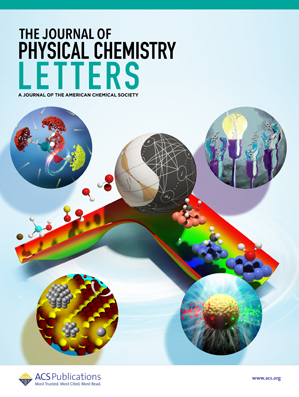Watching Vibrations Steer Electrons: Ultrafast Vibration-Induced Absorption Switching through Real-Time Orbital Modulation in a Confined Quantum System
IF 4.8
2区 化学
Q2 CHEMISTRY, PHYSICAL
引用次数: 0
Abstract
Excess electrons (EEs), transient anionic species pivotal in radiation chemistry, catalysis, and optoelectronics, have long been stabilized via solvent interactions such as hydrogen bonding in water or polar solvent traps. While these systems enable electron localization, their environmental sensitivity, limited spectral tunability, and static confinement mechanisms restrict applications requiring dynamic control. Here, we introduce a solvent-free paradigm using a supramolecular electropositive cage (C60F60) to confine and strongly couple an electron with a triatomic CO2 molecule, bypassing traditional solvation limitations. Through ab initio molecular dynamics, we uncover CO2’s dual role as a nonlinear quantum actuator: Its bending vibration (∠OCO = 122–156°) steers sub-50 fs electron oscillation via synchronized s/p-orbital hybridization and polarity switching. Crucially, this vibration-EE coupling modulates the EE-orbital’s symmetry, switching Laporte-forbidden (∠OCO < 133°/UV-dark) to allowed (∠OCO ≈ 133–140°/invisible-light and ∠OCO > 140°/visible-light) transitions, thereby enabling vibration-induced absorption switching spanning 380–760 nm. The C60F60 cage enhances CO2’s electron affinity by 6.1 eV through noncovalent electrostatic stabilization, creating a vibrationally active yet chemically inert environment, a stark contrast to solvent-dependent systems. This platform reveals ultrafast coherence between molecular vibrations and electron redistribution, establishing a dynamic quantum confinement model in which mechanical motion directly dictates optical responses. By bridging triatomic molecular dynamics to macroscopic tunable luminescence, this work advances the design of stimuli-responsive optoelectronic materials, offering applications in wavelength-adaptive scintillators and ultrafast optical switches while redefining the role of vibrations in quantum state manipulation.

观察振动引导电子:在受限量子系统中通过实时轨道调制的超快振动诱导吸收开关
过量电子(EEs)是辐射化学、催化和光电子学中至关重要的瞬态阴离子,长期以来一直通过溶剂相互作用(如水中氢键或极性溶剂陷阱)来稳定。虽然这些系统能够实现电子定位,但它们的环境敏感性、有限的光谱可调性和静态约束机制限制了需要动态控制的应用。在这里,我们引入了一种无溶剂范例,使用超分子电正笼(C60F60)来限制电子与三原子CO2分子的强耦合,绕过了传统的溶剂化限制。通过从头算分子动力学,我们揭示了CO2作为非线性量子致动器的双重作用:它的弯曲振动(∠OCO = 122 ~ 156°)通过同步s/p轨道杂化和极性切换来引导低于50 fs的电子振荡。至关重要的是,这种振动- ee耦合调制了ee轨道的对称性,改变了拉波特禁态(∠OCO <;133°/UV-dark)至允许(∠OCO≈133 - 140°/不可见光及∠OCO >;140°/可见光)跃迁,从而实现380-760 nm范围内的振动诱导吸收开关。C60F60笼通过非共价静电稳定将CO2的电子亲和力提高了6.1 eV,创造了一个振动活跃但化学惰性的环境,与依赖溶剂的系统形成鲜明对比。该平台揭示了分子振动和电子再分配之间的超快相干性,建立了机械运动直接决定光学响应的动态量子约束模型。通过将三原子分子动力学连接到宏观可调谐发光,这项工作推进了刺激响应光电子材料的设计,提供了波长自适应闪烁体和超快光开关的应用,同时重新定义了振动在量子态操纵中的作用。
本文章由计算机程序翻译,如有差异,请以英文原文为准。
求助全文
约1分钟内获得全文
求助全文
来源期刊

The Journal of Physical Chemistry Letters
CHEMISTRY, PHYSICAL-NANOSCIENCE & NANOTECHNOLOGY
CiteScore
9.60
自引率
7.00%
发文量
1519
审稿时长
1.6 months
期刊介绍:
The Journal of Physical Chemistry (JPC) Letters is devoted to reporting new and original experimental and theoretical basic research of interest to physical chemists, biophysical chemists, chemical physicists, physicists, material scientists, and engineers. An important criterion for acceptance is that the paper reports a significant scientific advance and/or physical insight such that rapid publication is essential. Two issues of JPC Letters are published each month.
 求助内容:
求助内容: 应助结果提醒方式:
应助结果提醒方式:


